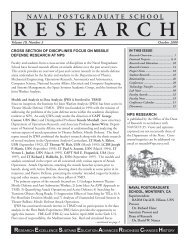Spectral Unmixing Applied to Desert Soils for the - Naval ...
Spectral Unmixing Applied to Desert Soils for the - Naval ...
Spectral Unmixing Applied to Desert Soils for the - Naval ...
Create successful ePaper yourself
Turn your PDF publications into a flip-book with our unique Google optimized e-Paper software.
spectrum by atmospheric effects. Reflectance spectrum B shows <strong>the</strong><br />
spectrum after removal of <strong>the</strong> atmospheric effects. .........................................37<br />
Figure 18. This figure shows a series of non-atmospherically corrected spectra<br />
collected with <strong>the</strong> ASD spectrometer. .............................................................38<br />
Figure 19. This figure illustrates <strong>the</strong> original sample radiance data (red) and white<br />
reference spectrum (black) collected with <strong>the</strong> ASD spectrometer (left)<br />
compared <strong>to</strong> <strong>the</strong> spectrum calculated using spectral math (right). The blue<br />
reflectance spectrum (right), represents <strong>the</strong> red spectrum (left) divided by<br />
<strong>the</strong> black spectrum (left) (solar spectrum removed). .......................................40<br />
Figure 20. This figure from Boardman and Kruse (2011) shows how mixing in a<br />
picture element (pixel) occurs based on 2 (left) and 3 (right) endmember<br />
concepts. The 3 endmember example shows how this occurs both<br />
spatially and spectrally within <strong>the</strong> pixel...........................................................41<br />
Figure 21. This figure shows <strong>the</strong> processing methods <strong>for</strong> spectral mixing analysis<br />
using <strong>the</strong> N-dimensional approach adapted from Kruse et al., (2003) and<br />
Boardman and Kruse (2011). ...........................................................................42<br />
Figure 22. The plot (A) shows that <strong>the</strong> eigenvalues calculated <strong>for</strong> <strong>the</strong> image drop<br />
<strong>to</strong>ward 1 at approximately eigenvalue band 50, meaning that most of <strong>the</strong><br />
data in this band is noise. The bot<strong>to</strong>m figure (B) is a visualization of<br />
eigenvalue band 50, confirming that though <strong>the</strong>re is some signal present,<br />
band 50 is dominated by noise. ........................................................................45<br />
Figure 23. This figure illustrates <strong>the</strong> number of times a pixel is marked as pure and<br />
shows <strong>the</strong> leveling off of pixels at around 2000. Analysis of this graph<br />
helps <strong>to</strong> determine how many pixels <strong>to</strong> use in visualization and<br />
endmember derivation. ....................................................................................47<br />
Figure 24. This figure is a comparison between <strong>the</strong> imagery derived endmembers<br />
(<strong>to</strong>p) and <strong>the</strong> spectra collected from Owens/Death Valley Mazourka<br />
Canyon (bot<strong>to</strong>m). Looking at <strong>the</strong> two plots, one sees similarities between<br />
<strong>the</strong> two so it is feasible that using <strong>the</strong> collected spectral library may be<br />
useful as an endmember input <strong>for</strong> <strong>the</strong> AVIRIS imagery..................................48<br />
Figure 25. This figure shows ASD collected soil spectra under various conditions of<br />
impaction/surface disturbance with <strong>the</strong> continuum removed. Variation in<br />
feature depths and widths at 500 nm, 1100–1125 nm, and 2200 nm are<br />
measureable, supporting <strong>the</strong> prediction that surface disturbances are<br />
detectable in Hyperspectral imagery. The depths of features show an<br />
overall pattern of decreasing feature depth with increasing disturbance at<br />
500 nm and 2200 nm. At 1125 nm <strong>the</strong> depth of features seemed <strong>to</strong><br />
increase, <strong>for</strong> <strong>the</strong> most part, with increasing disturbance. .................................50<br />
Figure 26. This figure shows undisturbed and disturbed BSC spectra collected from<br />
Mazourka Canyon plotted with bare soil. These BSCs have a prominent<br />
absorption feature around 650 nm similar <strong>to</strong> that observed by Weber et al<br />
(2008) that is useful <strong>for</strong> discrimination from bare soils. The absorption<br />
feature at 650–700 nm changes in width and depth between BSCs. Also,<br />
as mentioned by Weber et al (2008) <strong>the</strong> bare soil does not express <strong>the</strong><br />
absorption feature. The feature exhibited by <strong>the</strong> spectra at around 760 nm<br />
xi
















